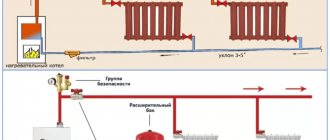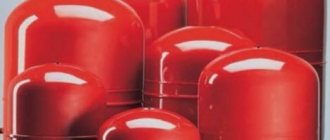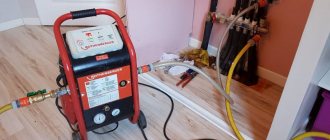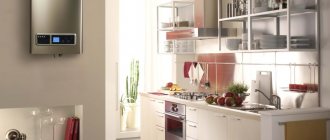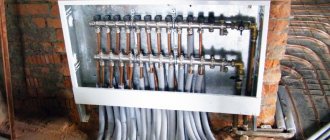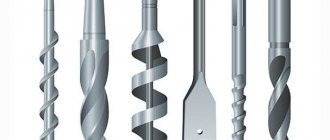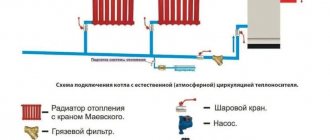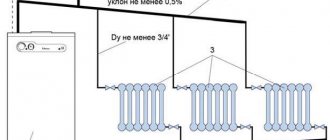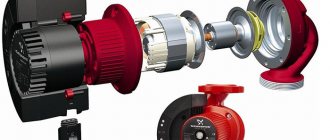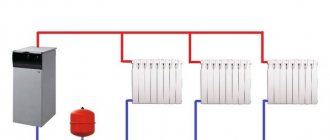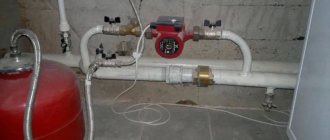Heating an individual house is one of the main conditions for long-term residence of residents in it; the level of comfort for people in the premises, ease of maintenance and financial costs for fuel depend on its normal functioning and structural design. To prevent negative consequences in emergency situations in cold weather associated with power outages and freezing of water in the system, antifreezes act as the heat supply medium, and the consumer should know how to fill a closed-type heating system with antifreeze.
Anti-freeze agents are classified as products that have a limited service life; during operation, pipes, heat exchange devices and fittings gradually accumulate contaminants. Therefore, during operation, it is necessary to repeatedly drain and fill the circuit with an antifreeze composition after flushing or temporary decommissioning of pipelines and branches of heated floors, boilers, and radiators.
Rice. 1 Closed system nodes
Open and closed heating systems: filling principle
The open system is equipped with an expansion tank at its highest point. The surface of the coolant fluid in it is in direct contact with atmospheric air. The closed system is equipped with a membrane expansion tank, hermetically sealed from the atmosphere.
Heating systems of any type can be filled as follows:
- tap water supplied to the lowest point of the system - through the make-up valve;
- water (distilled) or antifreeze, supplying liquid from a container (well, reservoir):
- by pouring manually and/or using a pump to the top point (fitting under the air vent or through an open expansion tank);
- pumping through the lowest point - the make-up inlet.
Many homeowners know the simplest (and worst!) way to fill open systems through an expansion tank. Water/antifreeze is poured inside with breaks to release air. It is not recommended to repeat this method in closed systems using the pipes of the upper air vents. The air that initially fills the system passes up through the layer of water being poured, dissolving in it. Air locks that prevent the flow of water through pipes and radiators will be guaranteed.
Then how to fill a closed heating system? The recommended method of filling any heating systems is to supply fluid under pressure (from a water supply or container via a pump) through the bottom fill valve.
Location of the heating system make-up unit.
When filling with coolant
There are only two known situations that require this technological operation:
- putting heating into operation (at the beginning of the heating season);
- restart after repair work.
Typically, coolant water is drained in late spring for two reasons:
- Water inevitably becomes contaminated with corrosion products (inside radiators, metal-plastic and polypropylene pipes are not susceptible to it). If you leave old water for the new season, you risk breaking the circulation pump with solid contaminants.
- Flooded systems of country houses that have not been started can “defrost” during a sudden cold snap - such cases are not uncommon. In this sense, antifreeze coolant is preferable. The high-quality composition has high anti-corrosion properties, increasing the drain interval to 5-6 years. There are known cases of uninterrupted heating operation with the same volume of antifreeze for 15-17 years. It is recommended to drain low-quality antifreeze after 2-3 years.
Pumping antifreeze into the heating system.
Popular circulation pump models
In the segment of “dry” units of the pressure equipment range for water heating systems, we can recommend the following models:
Heating circulation pump Wilo Stratos GIGA 40/1-51/4.5
Pump Wilo Stratos GIGA 40/1-51/4.5
- Generating a 50-meter head and a flow rate of 40-45 cubic meters per hour (about 700 liters per minute).
- Such a device is capable of servicing the heating system of a supermarket, assembly or production workshop, or medium-sized warehouse. Moreover, the operating characteristics of the unit vary over a wide range, by calibrating the power of the pump motor.
- The cost of this model is 220-230 thousand rubles.
Grundfos TPE Series 1000 dry rotor pump
Grundfos TPE Series 1000 pumps
- Generates a 90-meter head and a flow rate of 300-330 cubic meters per hour (about 5000 liters per minute).
- This device can serve the heating system of a small factory, large warehouse or multi-story building.
- The working chamber of the pump can withstand temperatures up to 140 degrees Celsius, allowing the use of more efficient media as a coolant than ordinary water.
- The cost of such a pump is up to 490 thousand rubles.
In the segment of “wet” units, in our opinion, the following models deserve close attention:
Circulation pumps for heating Grundfos from the UPS 32/80 series
Pump Grundfos UPS 32-80
- Providing 8-meter pressure at a flow rate of 12 cubic meters per hour (about 200 liters per minute).
- Such a pump is suitable for both a small store and an average cottage with a couple of floors.
- The features of this model are its small dimensions - the installation length of the unit is only 18 centimeters, and the weight is 4.5 kilograms.
- In addition, the pump can operate at three speeds, consuming between 60 and 100 watts of energy per hour.
- The cost of this semi-industrial device is 14-15 thousand rubles.
Circulation pump HALM HUPA 30-6.0 U180
Circulation pump Halm HUPA 30-6.0 U 180
- providing a 6-meter head and a flow rate of 3.6 cubic meters per hour (60 liters per minute).
- Such a unit is suitable for the heating system of a one-story house, small-sized cottage or small outbuilding.
- However, the energy consumption of this pump at the maximum – third – speed is only 45 W/hour, which is quite acceptable for the “household” segment.
- The cost of the pump - 5000-5200 rubles - looks very attractive, especially considering that the HALM HUPA 30-6.0 U180 is produced in Germany.
We also recommend watching:
- Types and tips for choosing infrared wall heaters
- How to choose a geyser - overview of manufacturers and models
- The principle of heating control via a GSM node
- Combined indirect heating water heater
Filling technology: where to supply coolant
The necessary means are a container and a pump that creates the required pressure of the coolant liquid. Submersible type “Gnome” or “Kid” are quite suitable (popular with gardeners who use them for watering areas located above the levels of reservoirs). There is evidence of successful filling of closed systems using hand pumps - from those used for spraying protective solutions on garden crops, to specialized hand pumps used for pumping motor fuels or liquid chemicals from drums. Any heating circuit can be successfully filled by monitoring the pressure using a pressure gauge.
Filling the system with antifreeze using a submersible vibration pump.
The first step is to select the fluid entry point. If the pressure created by the pump raises the liquid to the top of the system, it should be connected at the lowest point of the boiler room - the coolant make-up pipe, cut into the “return” in front of the boiler. In addition to the make-up inlet, a structurally separate drain outlet is required (two different system components). The first is equipped with a valve (ball valve) and a check valve, the second - only with a valve (ball valve). If the lowest point of the system is the water drain fitting from the boiler, then you can drain/fill the system with water through it. Since a check valve is not installed behind the boiler drain (behind the drain at all), any shutdown of the pump will cause the pumped liquid to leak out - you need to quickly turn off the tap in front of the fitting.
Design of a typical drain/recharge unit.
Filling the system from below
So, let's get back to pumping fluid into the system. We use a container of suitable volume (a 200-liter plastic barrel works well). We lower a pump into it, creating the pressure required for pumping liquid no higher than 1.5 atm (typical value in the range of 1-1.2 atm). Such pressure requires the pump to create a pressure of 15 m (for the submersible “Malysh” it reaches 40 m).
Having filled the barrel with water, we start the pump, monitoring the liquid level, which should be located above its inlet pipe to prevent “airing”. The level drops - add water. Antifreeze should be pumped from a smaller container (bucket) so as not to immerse the submersible pump housing in the liquid (and then wash it) - just immerse the inlet pipe. You will have to add antifreeze frequently, turning off the pump periodically.
Filling the system is carried out with Mayevsky taps open on installed heating radiators with substitute containers for collecting water. When liquid comes out of all air vents, close the taps and continue the injection process.
We control the pressure using a pressure gauge (a boiler gauge will do). When its value exceeds the hydrostatic pressure, equal to the pressure in the liquid column height from the bottom to the top point of the system (a height of 5 m gives a static pressure of 0.5 atm), we continue to fill the system, monitoring with a pressure gauge the moment the pressure reaches the required value.
Pumping antifreeze with the “Malysh” pump.
Having filled the system, turn off the pump, open the air valves (the pressure will inevitably drop), and then pump up the water. We repeat the process several times, displacing air bubbles.
We complete the filling by inspecting the system for leaks. After the pump is turned off, the liquid in the hose connected to the outlet pipe is under pressure. If antifreeze was pumped in, first disconnect the hose from the pump inlet pipe and drain the liquid into a container, being careful not to drench the mechanism body.
How to properly fill a closed heating system from above
If there is no electric pump, then filling the system, which has a height difference between the lower and upper points of 10 m, using a hand pump is a rather tedious procedure. In this case, the closed system can be filled through the upper point (for example, the connection fitting of an automatic air vent) by gravity with the drain valve open at the lower point until water begins to flow out of it. The drain valve closes, and at the bottom point of the system we have static pressure equal to the pressure in the liquid column up to the top point (at 10 m the pressure will be 1 atm).
Now you need to increase the pressure to a design level of no higher than 1.5 atm. We connect a regular watering hose about 1.5 meters long to any fitting of the system via a ball valve. We are coming up with an easily removable adapter for it to the hose of a regular car pump with a pressure gauge. We fill the vertically straightened hose with water, attach a pump through the adapter and pump water from the hose into the system with air. Close the ball valve. 3-5 repetitions of the process are enough to increase the initial static pressure at any point in the system by 0.5 atm. Avoid pumping air into it.
Injecting antifreeze with a hand pump.
Water quality requirements
If it is necessary to dilute antifreeze, it is necessary to use distilled water.
If distilled water is not available, the quality of the water used must meet all the requirements listed below. Elevated levels of calcium and magnesium contribute to scale problems, while excess levels of chlorides and sulfates can cause corrosion of the cooling system. If tap or natural water is used, the levels of impurities in it should not exceed the specified limits for use in cooling systems. Table - Water quality requirements
| Substance | Maximum permissible level |
| Calcium, magnesium (hardness) | 170 ppm (as CaCO3) |
| Chlorides | 40 ppm (as Cl) |
| Sulfates | 100 ppm (as SO4) |
Selecting pressure values in the system and expansion tank
The higher the operating pressure of the coolant, the less likely it is that air will enter the system. It is necessary to remember that the operating pressure is limited to the maximum permissible value for the heating boiler. If, when filling the system, a static pressure of 1.5 atm (15 m of water column) was reached, then the circulation pump with a pressure of 6 m of water. Art. will create a pressure of 15 + 6 = 21 m of water column at the entrance to the boiler.
Some types of boilers have a working pressure of about 2 atm = 20 m water column. Be careful not to overload the boiler heat exchanger with unacceptably high coolant pressure!
The membrane expansion tank is supplied with a factory set pressure of inert gas (nitrogen) in the gas cavity. Its common value is 1.5 atm (or bar, which is almost the same). This level can be raised by pumping air into the gas cavity with a hand pump.
Initially, the internal volume of the tank is completely occupied by nitrogen, the membrane is pressed against the body by the gas. That is why closed systems are usually filled to a pressure level of no higher than 1.5 atm (maximum 1.6 atm). Then, by installing the expansion tank on the “return” in front of the circulation pump, we will not get a change in its internal volume - the membrane will remain motionless. Heating the coolant will lead to an increase in its pressure, the membrane will move away from the tank body and compress the nitrogen. The gas pressure will increase, balancing the coolant pressure at a new static level.
Pressure levels in the expansion tank.
Filling the system to a pressure of 2 atm will allow the cold coolant to immediately press the membrane, which will also compress the nitrogen to a pressure of 2 atm. Heating water from 0 °C to 100 °C increases its volume by 4.33%. The additional volume of liquid must enter the expansion tank. The large volume of coolant in the system gives a large increase in its growth when heated. Too much initial pressure of the cold coolant will immediately use up the capacity of the expansion tank; it will not be enough to receive excess heated water (antifreeze). Therefore, it is important to fill the system to the correctly determined coolant pressure level. When filling the system with antifreeze, you need to remember that its coefficient of thermal expansion is greater than that of water, which requires the installation of a larger capacity expansion tank.
Conclusion
Filling closed heating systems is not just a standard final step before commissioning. Correct or incorrect execution of this step can seriously affect the performance of the system, in the worst case, even destroy it. Compliance with filling technology is the key to obtaining stable heating.
What to consider when choosing antifreeze
When buying antifreeze, pay attention to the following indicators:
- temperature range at which the coolant performs its functions - the wider it is, the better;
- heat capacity, that is, the amount of coolant consumed to pump a unit of time to transfer the required amount of heat, while losses should be minimal;
- viscosity coefficient, on which the speed of its circulation, heat transfer, etc. depends;
- corrosive activity in relation to the materials of the elements from which the heating system is assembled;
- safety for nature and people;
- low viscosity - the higher the indicator, the lower the efficiency;
- inertness to foaming, on which the efficiency of the pump depends.
Attention! The composition should not contain substances that make polymers and other materials brittle and lead to their destruction.
Inertness to foaming is one of the main quality indicators
